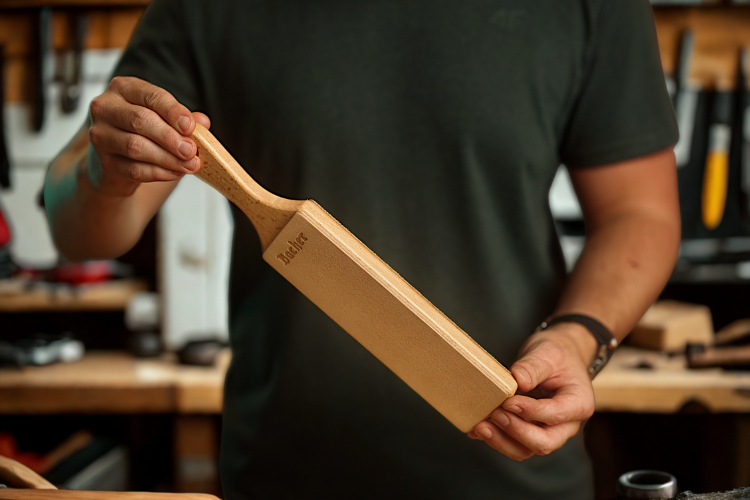Looking for a mirror-like finish without any scratches or burrs? Take care of your leather strop! Find out how to refresh it in 5 minutes, what to avoid and how to store it so it lasts for years, making sure every strop session is effective and safe.
Once you've sharpened your blade, the last thing you want to do is mess up the edge. That's where a leather strop comes in. It's the final step in edge care and it'll make sure your blade is as sharp as it can be. If you take care of your strop, it'll keep your blade shining and your blade's edge sharp. But if you don't, it'll lose its grip, get stained, and mess up your edge. Here's a quick rundown of how to look after it, what to avoid, and how to work safely.
Strop reset in 5 minutes
Remove excess paste
- When you're done: if the surface is "greasy", wipe it dry with a soft cloth; the coating should leave a thin film, not a thick layer. When it comes to coating, less is more.
- Every 30–50 knives: Just add 0.5–1g of fresh paste to each side, instead of adding a big amount at once. This keeps the abrasive even.
- Just a heads-up, though – don't mix grits on the same side. Changing paste? First, make sure you get the old one off properly – you don't want any of the finer grit getting stuck in the leather.
Deeper cleaning before changing honing compound
- Use a blunt edge/spatula to scrape off the top layer.
- Sand the remains with P100 sandpaper (evenly over the entire surface).
- Vacuum/shake out the leather and board.
Once prepared in this way, the leather strop for knife polishing is ready for fresh paste or a little balm.
alm.
You might need to replace the paste "from scratch" after 300-500 knives (or when the strop is noticeably less efficient).

Balm? Just do it when you really need to
- You don't need to use any balm on a new strap because the vegetable-tanned leather is hard enough for the abrasive work. If you soften too much at the start, it'll end up looking glossy and you'll need to use really light pressure.
- Here are a few signs that it needs to be conditioned: if the leather dries out, it starts to lose its elasticity, and it develops little micro-cracks, then you'll probably want to give it a little moisture. This probably happens after 2-3 years, or about 200-300 polished knives.
- Use about 1 ml on each side, and then massage it in. When it's been soaked up, put on some more. A little goes a long way to helping the paste absorb better after you've done the work.
Don't worry, this is par for the course: the paste goes grey over time because of the metallic dust collected from the edges, but it'll have no impact on how well it works.
Simple tips for storing your strop that will last for years
- Keep the strop flat, in a dry place, away from heat and sunlight; the leather shouldn't dry out or absorb moisture.
- Protect from dust (cover/drawer) - dust is an uncontrolled "grain".
- Just a heads-up: don't put sharp objects on the work surface. Use the side as it's meant to be used (e.g. use white paste on the rough side and green paste on the smooth side – this is a common configuration)
5 things that can get in the way of your productivity and how to quickly fix them
1. There's too much pressure. You can see this because the edges are rounding and the skin isn't gripping properly.
Correction: Just use the weight of the knife itself – the leather and paste are there to polish, not knead.
2. Wrong angle. If you've got marks that go beyond the edge, it's probably down to the angle you're working at.
Correction: effective blade polishing requires maintaining the angle from the sharpening stage; guide the blade steadily along its entire length.
3. Moving to the edge (edge-leading)
There is a risk of the skin being cut or of there being burrs on the edge.
Correction: always edge-trailing — the back leads the movement.
4. Dirty leather and mixing of gradations
Symptoms include scratches, unpredictable effects and 'smudging'.
Correction: do not mix different types of polishes. When changing grit, remove all of the old polish (scrape and use P100).
5. The layer of paste is too thick
Symptoms: things look a bit smudged and dirty.
Correction: use it in small amounts – about 1 gram on each side for the first time, and then 0.5 to 1 gram.
The golden rules for safety and effectiveness
- For a stable setup, put the board on a countertop or a mat that doesn't slip, with the handle sticking out past the edge of the table.
- The direction of movement is always away from you. The edge moves "behind" the blade, never touching the skin. This is the key to quality and safety.
- The pace should be slow and steady. 10 to 20 repetitions on each side is usually enough. Check the effect by using a light or magnifying glass, rather than rushing out of habit.
- Spinal flips. When you flip the knife, roll it across the spine to stop the blade digging into the leather.
- Control breaks. Every few strokes, test the paper or hair; when it's "glassy", stop — too much movement can make it worse..
Quick service puller
- After each session: dry the strop; place it in a cover/drawer.
- Every 30–50 knives: add 0.5–1 g of paste per side.
- When changing gradation: scrape + P100 , vacuum, possibly 1 ml of balm/side → new paste.
- Every 300–500 knives: complete replacement of paste; if the leather dries out, balm.
- Always: movement away from you , light pressure, clean hands and blade.
Summary: There are three basic rules – purity, moderation and safety
There are three things to remember when you are cleaning your leather strop: make sure it is clean and dry, use a gentle, refreshing cleaner and be very careful. If you follow these rules and the dosages in the cheat sheet above, you'll keep your knife blade looking great for years to come.

